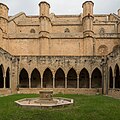| Cathedral of Saint Mary | |
|---|---|
 The cathedral in the midst of the old city | |
| Religion | |
| Affiliation | Roman Catholic |
| District | Tortosa |
| Year consecrated | 1447 |
| Location | |
| Location | Tortosa, Catalonia |
| Geographic coordinates | 40°48′52″N0°31′21″E / 40.81444°N 0.52250°E |
| Architecture | |
| Type | Cathedral |
| Style | Gothic and Baroque |
| Groundbreaking | 1347 |
| Completed | 1757 |
The Catedral of Saint Mary of Tortosa is a cathedral located in Tortosa, Catalonia, Spain and seat of the Diocese of Tortosa. The present structure is located in the center of the city's old town.










